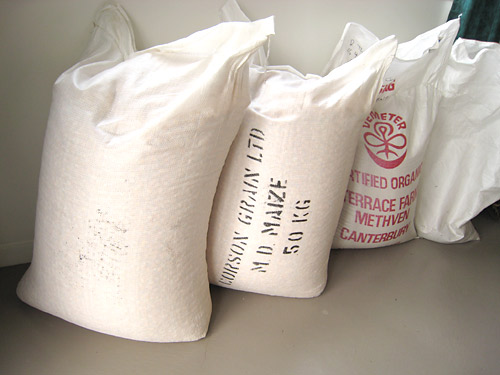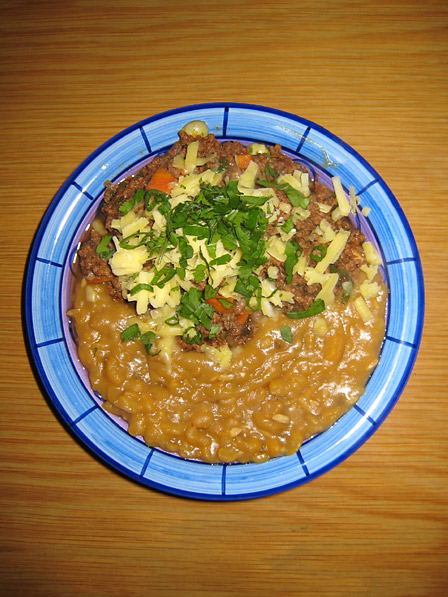If we are looking at producing our own grains in this bio-region, maize (field corn) is obviously one of the best suited for our particular conditions. Kevin and I are starting an experimental crop of Indian Flint Corn this season, in hopes of starting ourselves down the path of producing our own grains.
In preparation for producing and processing our own maize, we thought it would be a good idea to start practicing with some bought maize. It was amazingly difficult to find a source of New Zealand whole kernel maize for human consumption. Finally, through a friend, we found a way to get hold of some 50kg sacks of maize for a reasonable price. It wasn’t easy, but now we finally have 100kg of whole-kernel maize (a yellow dent variety) here on the Farmlet. 100kg is a lot of maize! Still, since the price of grain seems to be going nowhere but up these days, we figured we might do well to keep a little stockpile! We hope this supply will tide us over until we are producing enough maize of our own.

50KG sacks of maize (left), 25KG sacks of hard wheat berries (right)
Maize is much more nutritious if it is “nixtamalized” (soaked and boiled in an alkali solution) before being eaten, so that is what we want to do. We are full of plans for trying to make our own posole, tamales, and grits.
I had a first try at nixtamalising some of the maize yesterday. As per the instructions in “The Encyclopedia of Country Living,” I soaked it in a baking soda solution and then boiled it for quite a while to loosen the skins. They came off much easier than the book said they would — but I think that was because I got distracted and left the pot boiling longer than I should have. Oops! It was good that the skins came off easily, but the kernels had become very fragile and some were rather falling to bits! We have a lot to learn about this matter! After a great deal of rinsing, I further boiled the resulting product. It tastes a lot like the posole (hominy) that we used to be able to buy in a tin in the USA, except it’s yellow rather than white, and the kernels are falling apart rather than staying intact. I don’t know why it failed to turn white as I believe it ought to. Perhaps the alkali solution wasn’t strong enough?? Is it because of the type of corn we’re using? Since the kernels haven’t turned white, I’m not sure if we can actually say that the corn has been nixtamalized successfully. This is all very perplexing! Still, we are going to try some of this corn product for dinner tonight — trying to eat it as a polenta/hominy-type hybrid. It seems like it will taste ok, even if further experimentation is still needed to get it just right. (I made a bunch of it, and am hoping it tastes good enough to merit freezing in meal-sized batches for “fast-food” dinners!)
Plans for further maize-preparation experiments:
*Try using lime water or lye (if I can find any lye around here) to soak the maize instead of baking soda.
*Try the cold-soak (no-boil) method mentioned in “The Encyclopedia of Country Living.” This takes a lot longer, but would be much more energy-efficient
*”Nourishing Traditions” gives a recipe where you first grind the maize, and then soak it in lime water before cooking. I’d like to grind some of the maize in our grain mill and see how this recipe works out as well.
We hope that with time and practice we’ll learn which methods of preparing the maize are easiest, tastiest, and most nutritious.
Update:
We had some of the corn mixture for dinner, cooked up with a little salt, butter and rapadura. We served it with beef chili and cheese, plus a green salad from the garden, and found it very tasty.

Corn chili meal
Ag lime + water + soaking for 2 or 3 days = lime water
Wood ash + water + soaking for 2 or 3 days = lye.
We’ve been using the chookfood (crushed yellow maize) a lot lately for making corn breads. Haven’t got as far as the whole lime-soaking thing, yet, but planning on it, so you guys are ahead of us there 😉 Mainly I want to make authentic-tasting Tacos — the bought things (apart from being noxiously industrial, judging by the ingredients list) are outrageously expensive here.
My corn grown experiment this year was a complete failure. The harvest period for sweet corn is extremely narrow and I was mostly too late. Then I found that processing dried corn is not easy– I would buy special equipment if I had to do it again. I ended up throwing whole ears to the chickens…
I would probably focus on amaranth if I really wanted to do small scale grain production. It is much easier to deal with. Too bad it doesn’t taste as good as corn!
Hi there, we are also having a hard time finding maize that’s not animal feed. Any chance you could share your secret? By the way, we enjoy your blog very much, keep it up!
Dominic Anfiteatro in South Australia has a great site with HEAPS of stuff – he’s an authority on Kefir, among other things… You guys may already know of him:
http://users.sa.chariot.net.au/~dna/index.html
Here’s a bit on making Lye:
http://users.sa.chariot.net.au/~dna/Makekefir.html#potash-lye
Go down to almost the bottom of the page!
Hi All, and thanks for the comments.
@Mike: I’m intending to have a go at the lime method, and maybe lye also. I’ll keep everyone posted about the results! Having lived in Southern California, Kevin and I are both craving various Mexican corn treats that are expensive or unobtainable here, so we know how you feel about the tacos!
@Culley: Sorry to hear about the problems you had with the corn. We know of a number of people who have grown sweetcorn and maize around here on a small scale with considerable success, so we are hopeful that it will work out for us. Our neighbours had a go at growing amaranth, but said they had a lot of trouble with birds stealing the crop. Someone else said they had trouble with rain at harvest time. Still, we’d like to try growing amaranth at some stage.
@Sarah: As indicated by the labels on the sacks, the maize comes from an outfit called “Corson.” They are easy to find online, but the problem is that they really don’t seem interested in selling to small buyers. It seems that’s simply not what they are set up for. My friend and her husband had almost given up on even getting a reply from them, and she’s not sure we could manage to order through them again. That’s partly why we ordered so much maize — because we don’t feel confident that we’d be able to get any more from that source! Still, you might give Corson a try, especially if you can team up with some others to order a larger amount of maize.
Glad you are enjoying this blog. I’ve enjoyed taking a look at your blog, too, especially the pictures of the Gotland pelt sheep. I have had a bit of a fascination with them for a while, and was delighted to see that you have some!
@IL: Thanks for the links. I’ve been to that site before for info on kefir, but had no idea he had all that neat information about making lye as well. Eeek! Making lye is something I’d like to get around to at some stage, but with spring planting in full swing and a baby due in about 6 weeks I have a sneaking suspicion that it might have to wait a while! Too bad we are not using a wood burning stove, as then we’d at least have a source of nice, clean wood ash on hand. That looks like more than half the battle! I’ve heard lye is meant to be the most effective agent for treating the corn — stronger than baking soda and lime water — so it would be nice to have some.
Cheers,
Rebecca
The yellow corn will make yellow hominy, and white corn will make white hominy. Both are great.
Hi Byron,
Thanks for sharing the insight about the white and yellow corn. In my ignorance, I hadn’t even realised that hominy could be any colour other than white! I feel very encouraged!
Cheers,
Rebecca